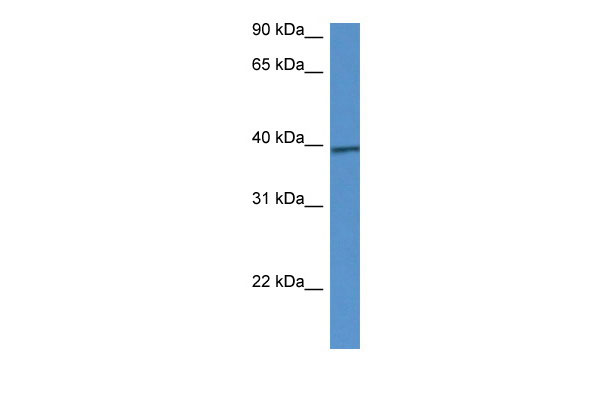EG546729 antibody - C-terminal region
Rabbit Polyclonal Antibody
- SPECIFICATION
- CITATIONS
- PROTOCOLS
- BACKGROUND

Application
| WB |
|---|---|
| Primary Accession | D3Z291 |
| Other Accession | NM_001081271, NP_001074740 |
| Reactivity | Human, Mouse, Rat, Rabbit, Pig, Horse, Bovine, Dog |
| Predicted | Human, Mouse, Rat, Rabbit, Pig, Horse, Bovine, Dog |
| Host | Rabbit |
| Clonality | Polyclonal |
| Calculated MW | 39kDa |
| Gene ID | 546729 |
|---|---|
| Alias Symbol | EG546729 |
| Other Names | Calcium homeostasis modulator protein 1, Calhm1 |
| Format | Liquid. Purified antibody supplied in 1x PBS buffer with 0.09% (w/v) sodium azide and 2% sucrose. |
| Reconstitution & Storage | Add 50 ul of distilled water. Final anti-EG546729 antibody concentration is 1 mg/ml in PBS buffer with 2% sucrose. For longer periods of storage, store at 20°C. Avoid repeat freeze-thaw cycles. |
| Precautions | EG546729 antibody - C-terminal region is for research use only and not for use in diagnostic or therapeutic procedures. |
| Name | Calhm1 {ECO:0000303|PubMed:22711817, ECO:0000312|MGI:MGI:3643383} |
|---|---|
| Function | Pore-forming subunit of gustatory voltage-gated ion channels required for sensory perception of sweet, bitter and umami tastes (PubMed:23467090). With CALHM3 forms a fast-activating voltage-gated ATP-release channel in type II taste bud cells, ATP acting as a neurotransmitter to activate afferent neural gustatory pathways (PubMed:23467090, PubMed:29681531). Acts both as a voltage-gated and calcium-activated ion channel: mediates neuronal excitability in response to membrane depolarization and low extracellular Ca(2+) concentration. Has poor ion selectivity and forms a wide pore (around 14 Angstroms) that mediates permeation of small ions including Ca(2+), Na(+), K(+) and Cl(-), as well as larger ions such as ATP(4-) (PubMed:22711817, PubMed:28734079, PubMed:29681531, PubMed:33788965). Mediates Ca(2+) influx and downstream activation of the ERK1 and ERK2 cascade in neurons (By similarity). Triggers endoplasmic reticulum stress by reducing the calcium content of the endoplasmic reticulum (By similarity). May indirectly control amyloid precursor protein (APP) proteolysis and aggregated amyloid-beta (Abeta) peptides levels in a Ca(2+) dependent manner (By similarity). |
| Cellular Location | Cell membrane {ECO:0000250|UniProtKB:Q8IU99}; Multi-pass membrane protein {ECO:0000250|UniProtKB:Q8IU99}. Endoplasmic reticulum membrane {ECO:0000250|UniProtKB:Q8IU99}; Multi-pass membrane protein {ECO:0000250|UniProtKB:Q8IU99}. Basolateral cell membrane; Multi-pass membrane protein Note=Localizes to the basolateral membrane of epithelial cells including taste cells (PubMed:30804437). Colocalizes with HSPA5 at the endoplasmic reticulum (By similarity). {ECO:0000250|UniProtKB:Q8IU99, ECO:0000269|PubMed:30804437} |
| Tissue Location | Specifically expressed in type II taste bud cells (at protein level). Not expressed in brain |

Thousands of laboratories across the world have published research that depended on the performance of antibodies from Abcepta to advance their research. Check out links to articles that cite our products in major peer-reviewed journals, organized by research category.
info@abcepta.com, and receive a free "I Love Antibodies" mug.
Provided below are standard protocols that you may find useful for product applications.
If you have used an Abcepta product and would like to share how it has performed, please click on the "Submit Review" button and provide the requested information. Our staff will examine and post your review and contact you if needed.
If you have any additional inquiries please email technical services at tech@abcepta.com.













 Foundational characteristics of cancer include proliferation, angiogenesis, migration, evasion of apoptosis, and cellular immortality. Find key markers for these cellular processes and antibodies to detect them.
Foundational characteristics of cancer include proliferation, angiogenesis, migration, evasion of apoptosis, and cellular immortality. Find key markers for these cellular processes and antibodies to detect them. The SUMOplot™ Analysis Program predicts and scores sumoylation sites in your protein. SUMOylation is a post-translational modification involved in various cellular processes, such as nuclear-cytosolic transport, transcriptional regulation, apoptosis, protein stability, response to stress, and progression through the cell cycle.
The SUMOplot™ Analysis Program predicts and scores sumoylation sites in your protein. SUMOylation is a post-translational modification involved in various cellular processes, such as nuclear-cytosolic transport, transcriptional regulation, apoptosis, protein stability, response to stress, and progression through the cell cycle. The Autophagy Receptor Motif Plotter predicts and scores autophagy receptor binding sites in your protein. Identifying proteins connected to this pathway is critical to understanding the role of autophagy in physiological as well as pathological processes such as development, differentiation, neurodegenerative diseases, stress, infection, and cancer.
The Autophagy Receptor Motif Plotter predicts and scores autophagy receptor binding sites in your protein. Identifying proteins connected to this pathway is critical to understanding the role of autophagy in physiological as well as pathological processes such as development, differentiation, neurodegenerative diseases, stress, infection, and cancer.


